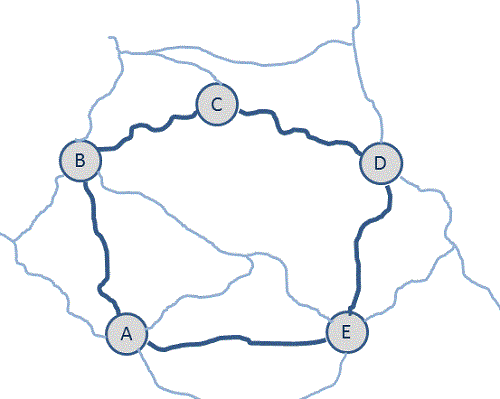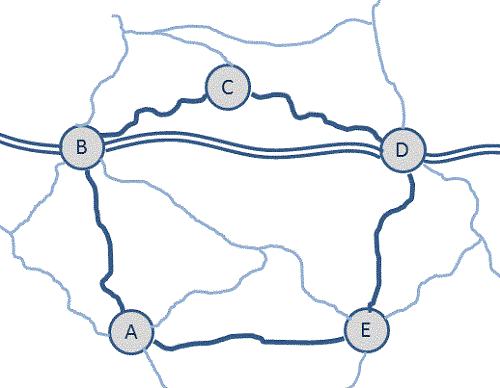Route planning
The choice between Advisory and Mandatory can be confusing to the newcomer, so let’s look at how a DIY ride is planned - and how the different options can be used to suit different circumstances:
Let’s say you want a 200km ride and you plan to ride from A to B to C to D to E and back to A.
The minimum rideable distance round that loop comes to just over 200km, and the shortest way between B and D is via C; so you can tell the organiser that you are just going to use controls A-B-D-E-A. The DIY organiser checks that meets the 200km minimum distance and approves the entry.
All you need to do as a rider is provide proof to the organiser that you’ve been to all those places, in order, and within the time limit. You can do that with receipts from those places or by means of a recorded GPS track (these are advisory routes).
You haven’t included C as a control, so on the day you can choose to ride through C or go a different way, it doesn’t matter – it’s what we call an ‘advisory route’.


Now, let’s suppose that a dual carriageway has been built between B and D.
You still want to use the pleasant lanes that go though village C (which will make your ride at least 200km), but the dual carriageway makes the ‘minimum rideable distance’ of A-B-D-E-A just less than 200 km.
You now need to prove that you have gone via C to make up the distance.
If you want to use the Traditional proof of passage (receipts) you’ll need to find an establishment at C where you can get a receipt. That’s not always possible, but if you have a GPS which records a track you can use GPS validation. All you need to do different is to tell the organiser you will be riding A-B-C-D-E-A, and you don’t even need to stop in C, the GPS record will tell the organiser you’ve been there.
So what's Mandatory route all about?
With increasing fast traffic on main roads it can be tough to create a safe, pleasant, route without adding either a lot of distance or an excessive numbers of controls – all of which you would have to declare on the entry form, and the organiser would have to check you’ve been there. The alternative is a DIY which allows you to declare to the organiser, not just the controls, but exactly which roads you will ride for your 200km by means of a planned GPS route. This is what we call a mandatory route.
When you have ridden using precisely those roads you upload the recorded track direct to the website; the organiser has some nifty software that enables a comparison of the two (and checks that you didn’t sneakily jump on a train between D and E).
Simple? Well, there are some downsides to mandatory routing:
- If you can’t provide a complete track because your GPS unit failed your ride will not be validated.
- If a road you have as part of your mandatory route is closed you will have to get evidence to show the organiser to show why you had to divert and also you must return to the route as soon as possible. Doing that can add quite bit of extra distance.
- If you get lost and deviate accidentally, you will have to return to the route at exactly the point you left it.
The item has been added to your basket
Click on the basket icon above to go to checkout